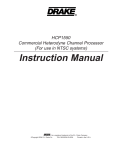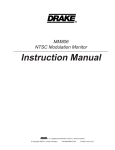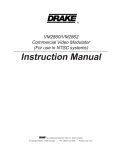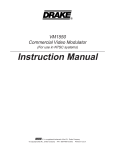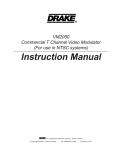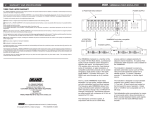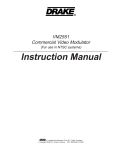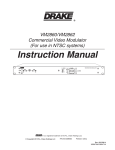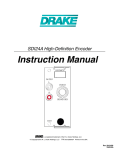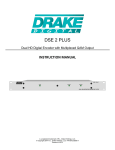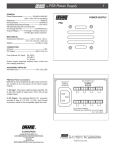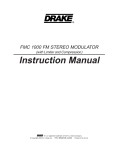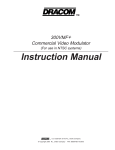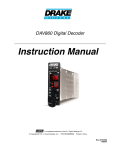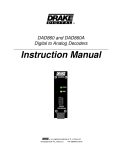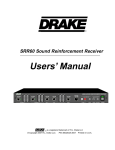Download DRAKE HCP2550A Instruction manual
Transcript
®
HCP2550A
Commercial Heterodyne Channel Processor
(For use in NTSC systems)
Instruction Manual
® is a registered trademark of the R.L. Drake Company
©Copyright 2002 R.L. Drake Co.
P/N: 3852423F-3-2002
Printed in the U.S.A.
ii
Caution Statements
WARNING: TO PREVENT FIRE OR
ELECTRICAL SHOCK DO NOT
EXPOSE TO RAIN OR MOISTURE
A product and cart combination should be moved
with care. Quick stops, excessive force and
uneven surfaces may cause the product and cart
combination to overturn.
RISK OF ELECTRIC SHOCK
DO NOT OPEN
The lightning flash with arrow head symbol, within
an equilateral triangle, is intended to alert the user
to the presence of uninsulated "dangerous voltage"
within the product's enclosure that may be of
sufficient magnitude to constitute a risk of electric
shock to persons.
CAUTION: TO REDUCE THE RISK OF ELECTRIC
SHOCK,
DO NOT REMOVE COVER
NO USER-SERVICEABLE PARTS INSIDE
REFER SERVICING TO QUALIFIED PERSONNEL
The exclamation point within an equilateral triangle
is intended to alert the user to the presence of
important operating and maintenance (servicing)
instructions in the literature accompanying
the product.
CAUTION
WARNING: TO REDUCE THE RISK OF FIRE OR ELECTRIC SHOCK, DO NOT EXPOSE THIS PRODUCT
TO RAIN OR MOISTURE.
DO NOT OPEN THE CABINET, REFER SERVICING TO QUALIFIED PERSONNEL ONLY.
CAUTION: TO PREVENT ELECTRIC SHOCK, DO NOT USE THIS (POLARIZED) PLUG WITH AN EXTENSION
CORD RECEPTACLE OR OTHER OUTLET UNLESS THE BLADES CAN BE FULLY INSERTED TO
PREVENT BLADE EXPOSURE.
ATTENTION: POUR PREVENIR LES CHOCS ELECTRIQUES, NE PAS UTILISER CETTE FICHE POLARISEE
AVEC UN PROLONGATEUR, UNE PRISE DE COURANT OU UNE AUTRE SORTIE DE
COURANT, SAUF SI LES LAMES PEUVENT ETRE INSEREES A FOND SANS EN LAISSER
AUCUNE PARTIE A DECOUVERT.
Important Safety Instructions
1. Read Instructions—All the safety and operating instructions should be read
before the product is operated.
2. Retain Instructions—The safety and operating instructions should be
retained for future reference.
3. Heed Warnings—All warnings on the product and in the operating
instructions should be adhered to.
4. Follow Instructions—All operating and use instructions should be followed.
5. Cleaning—Unplug this product from the wall outlet before cleaning. Do not
use liquid cleaners or aerosol cleansers. Use a damp cloth for cleaning.
6. Attachments—Do not use attachments that are not recommended by the
product manufacturer as they may cause hazards.
7. Water and Moisture—Do not use this product near water—for example,
near a bathtub, wash bowl, kitchen sink or laundry tub; in a wet basement;
or near a swimming pool; and the like.
8. Accessories—Do not place this product on an unstable cart, stand, tripod,
bracket, or table. The product may fall, causing serious injury to a child or adult,
and serious damage to the product. Use only with a cart, stand, tripod, bracket,
or table recommended by the manufacturer, or sold with the product. Any
mounting of the product should follow the manufacturer's instructions, and
should use a mounting accessory recommended by the manufacturer.
9. A product and cart combination should be moved with care. Quick stops,
excessive force, and uneven surfaces may cause the product and cart
combination to overturn.
10. Ventilation—Slots and openings in the cabinet are provided for ventilation
and to ensure reliable operation of the product and to protect it from
overheating, and these openings must not be blocked or covered. The
openings should never be blocked by placing the product on a bed, sofa, rug,
or similar surface. This product should not be placed in a built-in installation
such as bookcase or rack unless proper ventilation is provided or the
manufacturer's instructions have been adhered to.
11. Power Sources—This product should be operated only from the type of
power source indicated on the marking label. If you are not sure of the type of
power supplied to your home, consult your product dealer or local power
company. For products intended to operate from battery power, or other
sources, refer to the operating instructions.
12. Grounding or Polarization—This product may be equipped with a
polarized alternating-current line plug (a plug having one blade wider than the
other). This plug will fit into the power outlet only one way. This is a safety
feature. If you are unable to insert the plug fully into the outlet, try reversing
the plug. If the plug should still fail to fit, contact your electrician to replace
your obsolete outlet. Do not defeat the safety purpose of the polarized plug.
Alternate Warnings—If this product is equipped with a three-wire groundingtype plug, a plug having a third (grounding) pin, the plug will only fit into a
grounding-type power outlet. This is a safety feature. If you are unable to insert
the plug into the outlet, contact your electrician to replace your obsolete outlet.
Do not defeat the safety purpose of the grounding-type plug.
12 a. Mise à la terre ou Polarisation—Cet appareil est équipé avec un cordon
d'alimentation à trois fils. Il est a brancher sur une prise ayant un connecteur a
la terre. Assurez-vous que la connection a la terre ne manque pas.
13. Power-Cord Protection—Power-supply cords should be routed so that
they are not likely to be walked on or pinched by items placed upon or against
them, paying particular attention to cords at plugs, convenience receptacles,
and the point where they exit from the product.
iii
14. Outdoor Antenna Grounding—If an outside antenna or cable system is
connected to the product, be sure the antenna or cable system is grounded so
as to provide some protection against voltage surges and built-up static
charges. Article 810 of the National Electrical Code, ANSI/NFPA 70, provides
information with regard to proper grounding of the mast and supporting
structure, grounding of the lead-in wire to an antenna discharge unit, size of
grounding conductors, location of antenna-discharge unit, connection to
grounding electrodes, and requirements for the grounding electrode.
See Figure A.
15. Lightning—For added protection for this product during a lightning storm,
or when it is left unattended and unused for long periods of time, unplug it from
the wall outlet and disconnect the antenna or cable system. This will prevent
damage to the product due to lightning and power-line surges.
16. Power Lines—An outside antenna system should not be located in the
vicinity of overhead power lines, other electric light or power circuits, where it
can fall into such power lines or circuits. When installing an outside antenna
system, extreme care should be taken to keep from touching such power lines
or circuits as contact with them may be fatal.
17. Overloading—Do not overload wall outlets, extension cords, or integral
convenience receptacles as this can result in a risk of fire or electric shock.
18. Object and Liquid Entry—Never push objects of any kind into this product
through openings as they may touch dangerous voltage points or short-out
parts that could result in a fire or electric shock. Never spill liquid of any kind
on the product.
19. Servicing—Do not attempt to service this product yourself as opening
or removing covers may expose you to dangerous voltage or other hazards.
Refer all servicing to qualified service personnel.
20. Damage Requiring Service—Unplug this product from the wall outlet and
refer servicing to qualified service personnel under the following conditions:
a. When the power-supply cord or plug is damaged,
b. If liquid has been spilled, or objects have fallen into the product,
c. If the product has been exposed to rain or water,
d. If the product does not operate normally by following the operating
instructions. Adjust only those controls that are covered by the operating
instructions as an improper adjustment of other controls may result in damage
and will often require extensive work by a qualified technician to restore the
product to its normal operation,
e. If the product has been dropped or damaged in any way, and
f. When the product exhibits a distinct change in performance—this indicates
a need for service.
21. Replacement Parts—When replacement parts are required, be sure the
service technician has used replacement parts specified by the manufacturer
or have the same characteristics as the original part. Unauthorized substitutes
may result in fire, electric shock or other hazards.
22. Safety Check—Upon completion of any service or repairs to this product,
ask the service technician to perform safety checks to determine that the
product is in proper operating condition.
23. Wall or Ceiling Mounting—The product should be mounted to a wall or
ceiling only as recommended by the manufacturer.
24. Heat—The product should be situated away from heat sources such as
radiators, heat registers, stoves, or other products (including amplifiers) that
produce heat.
Figure A
Example of antenna grounding as per National Electrical Code, ANSI/NFPA 70
NOTE TO CATV SYSTEM INSTALLERS:
THIS REMINDER IS PROVIDED TO CALL THE
CATV SYSTEM INSTALLER'S ATTENTION TO
ARTICLE 820 - 40 OF THE NEC THAT
PROVIDES GUIDELINES FOR PROPER
GROUNDING AND, IN PARTICULAR,
SPECIFIES THAT THE CABLE GROUND
SHALL BE CONNECTED TO THE
GROUNDING SYSTEM OF THE BUILDING, AS
CLOSE TO THE POINT OF CABLE ENTRY AS
PRACTICAL.
ANTENNA
LEAD IN
WIRE
GROUND CLAMP
ANTENNA
DISCHARGE UNIT
(NEC SECTION 810-20)
ELECTRIC
SERVICE
EQUIPMENT
GROUNDING CONDUCTORS
(NEC SECTION 810-21)
GROUND CLAMPS
NEC - NATIONAL ELECTRIC CODE
POWER SERVICE GROUNDING
ELECTRODE SYSTEM
(NEC ART 250, PART H)
iv
Table of Contents / Specifications
TABLE OF CONTENTS
ii
Caution Statements
5
Installation
iii
Important Safety Instructions
7
List of OFF-AIR Type Input Channels
iv
Table of Contents / Specifications
8
List of CATV Type Input Channels
1
Description
9
List of Output Channels
2
Front Panel Controls and Indicators
10 Service / If You Need To Call For Help
4
Rear Panel Controls and Connections
11 Warranty
SPECIFICATIONS
INPUT SECTION
Frequency Range:
Input Impedance:
RF Input Level:
Adjacent Channel Rejection:
Noise Figure:
Tuner Image Rejection:
In-channel C/N:
AFC Range:
Pilot Threshold:
COMPOSITE IF LOOP
Output Level (V carrier):
Spurious Outputs:
Input Level (V carrier):
IF Input/Output Impedance:
Isolation:
OUTPUT SECTION
Frequency Range:
Output Level:
Output Impedance:
Video Frequency Response:
L-C Delay:
Frequency Stability:
FCC Offset:
A/V Ratio Adjustment:
Spurious Outputs:
Broadband Noise:
EAS INPUT
Input Level:
Input Impedance:
Auto Switching Level:
Isolation Between Composite and EAS Inputs:
GENERAL
AC Power Input:
Operating Temperature:
Dimensions:
Weight:
54 - 806 MHz:
Off-Air TV channels 2 - 69,
Standard CATV channels 2 - 125,
IRC and HRC channels 1 - 125.
75 Ohms, greater than 10 dB return loss.
-20 dBmV to +25 dBmV (preamp on).
-10 dBmV to +35 dBmV (preamp off).
Greater than 60 dB.
Less than 10 dB (preamp on).
Greater than 75 dB.
60 dB for input levels of +15 dBmV or greater (preamp on).
60 dB for input levels of +25 dBmV or greater (preamp off).
± 75 kHz minimum.
Typical adjustment range:
-20 dBmV to +5 dBmV (preamp on).
-10 dBmV to +15 dBmV (preamp off).
+28 dBmV ±2 dB.
-60 dBc minimum.
+28 dBmV nominal,
+30 dBmV maximum.
75 Ohms, greater than 15 dB return loss.
Greater than 60 dB.
82 channels, 54 to 550 MHz;
Channels 2 - 78 and 95 - 99.
+60 dBmV (typically adjustable from +50 to +60 dBmV).
75 Ohms, greater than 12 dB return loss.
20 Hz to 4.2 MHz, ±1.5 dB maximum.
±50 nSec.
±5 PPM of output frequency (AFC on),
±5 PPM of frequency difference between input and output signals (AFC off).
Automatic (plus, minus, or none is selectable).
+5 dB to -12 dB typical, relative to input A/V ratio.
-60 dBc.
-80 dBc (measured in a 4 MHz bandwidth at greater than ±12 MHz offset from
carrier at an output level of +60 dBmV).
+28 dBmV nominal.
75 Ohms, greater than 15 dB return loss with this port enabled.
Greater than +20 dBmV, nominal.
Greater than 60 dB.
115 VAC (±10%), 60 Hz, 30 Watts.
00 C to +500 C, ambient.
19" (481 mm) W x 1.75" (44 mm) H x 14.3" (363 mm) D.
10 lbs. (4.6 Kg).
Introduction - Description
RF INPUT
HCP2550A CHANNEL PROCESSOR
POWER
EAS
READY
PRE-AMP
OFF
ON
AFC
OFF
CATV + 100
CATV
OFF
AIR
IRC
HRC
STD
ON
CHANNEL PLAN
The R.L. Drake HCP2550A is a high quality, frequency
agile channel processor capable of converting any VHF,
UHF, or CATV input signal to any standard output channel
between 54 and 550 MHz. Input and output frequency
are easily set with front panel pushwheel switches.
Selectable preamp and AFC provide stable reception of
weak or out-of-tolerance signals. A/V ratio and output
level controls are also provided along with IF loop-thru
connections to offer exceptional flexibility.
The synthesized input tuning permits reception of Off-Air
TV channels 2 through 69, standard CATV channels
2 through 125, and IRC, HRC channels 1 through 125.
A selectable preamp ensures reliable reception of weak
input signals. Selectable AFC ensures that out-oftolerance cable channels, VCR modulators, or UHF
translator signals will not affect the IF or RF output
frequencies of the HCP2550A. A front panel indicator
lights for signals that are within the AFC lock range.
A selectable and adjustable threshold level control for the
input signal level is also provided. An internally generated
carrier is substituted for input signals below the set
threshold level. A front panel signal indicator lights for
input signal strengths greater than a threshold value.
The use of SAW filtering permits reliable adjacent channel
operation of multiple Channel Processor and modulator
units. IF loop-thru capability in the HCP2550A supplies a
padded IF output prior to channel conversion.
This feature provides the capability to replace the
standard internally generated IF output with an alternate
source of composite IF, or allows the insertion of IF
scrambling equipment.
1
RF OUTPUT
PILOT
THRESHOLD
4
4
INPUT
CHANNEL
LOCK
DETECT
SIGNAL
A/V
RATIO
OUTPUT
LEVEL
OUTPUT
ENABLED
7
8
OUTPUT
CHANNEL
The synthesized RF output can be set for any CATV
channel 2 through 78 and 95 through 99. FCC required
channel frequency offsets are automatically provided.
Offsets of ± and zero can be selected with a rear panel
switch. RF output level is front panel adjustable to
+60 dBmV maximum.
The output modulator section of the HCP2550A accepts
Emergency Alert System (EAS) signals as required by the
FCC Part 11 for many CATV systems. Either automatic or
manual activation of the Emergency Alert System input is
controlled by the rear panel (EAS) switch.
Coaxial connectors are provided for the RF Input, the IF
Loop-out and Loop-in, and the RF Output. All of the
above mentioned features, combined with a carefully
designed low intermodulation output stage, provide
reliable operation in a densely crowded SMATV or cable
environment.
2
Front Panel Controls and Indicators
F1
F2
F3
F4
POWER
F6 F7
F8
F9
RF INPUT
HCP2550A CHANNEL PROCESSOR
EAS
READY
F5
PRE-AMP
OFF
ON
AFC
OFF
CATV + 100
CATV
OFF
AIR
IRC
HRC
STD
ON
CHANNEL PLAN
F10 F11
F12
RF OUTPUT
PILOT
THRESHOLD
4
4
LOCK
DETECT
A/V
RATIO
OUTPUT
LEVEL
OUTPUT
ENABLED
SIGNAL
INPUT
CHANNEL
7
8
OUTPUT
CHANNEL
Figure 1
F1 – POWER Indicator
Lights when the unit is connected to a source of
AC power.
F2 – Preamp Switch
Switch to the ‘ON’ position to provide approximately 10 dB
of low noise amplification to the input signal.
F4 – CHANNEL PLAN Switches
Sets the type of channel, Off-Air or various CATV channel
plans.
- Setting the left-hand switch for “OFF AIR” electronically
locks out the right-hand switch.
OFF-AIR CHANNEL 25:
RF INPUT
F3 – AFC Switch
Switch to the ‘ON’ position to provide automatic frequency
control tuning of the input signal. The input signal must
be within ±75 kHz of an assigned off-air or CATV channel
for AFC capture. This feature, when activated, causes the
composite IF output signal to have its visual carrier locked
at 45.75 MHz. This AFC action ensures that the RF
output signal of the HCP2550A will automatically remain
at the assigned frequency of operation for a given channel
with any required FCC offset. It is recommended that
the AFC be switched on for all input and output
channel combinations, except when the output
channel is set for the same channel as the input. The
‘LOCK DETECT’ LED (see Item F6) will light to indicate
that both input signal synthesizers are locked and the
AFC function is active.
CATV + 100
CATV
OFF AIR
IRC
HRC
STD
CHANNEL PLAN
2
5
INPUT
CHANNEL
- Setting the left-hand switch for “CATV” ("CATV + 100")
also requires setting the right-hand switch for “IRC”,
“HRC”, or “STD” (standard) as desired for the given input
signal operating channel.
STANDARD CATV CHANNEL 25:
RF INPUT
CATV + 100
CATV
OFF AIR
IRC
HRC
STD
CHANNEL PLAN
2
5
INPUT
CHANNEL
- Setting the left-hand switch for “CATV +100” sets a
leading ”1” to the INPUT CHANNEL thumbwheel switch
for CATV channels from 100 through 125.
STANDARD CATV CHANNEL 125:
RF INPUT
CATV + 100
CATV
OFF AIR
IRC
HRC
STD
CHANNEL PLAN
2
5
INPUT
CHANNEL
Front Panel Controls and Indicators, continued
3
F5 – INPUT CHANNEL Number Switch
Sets the input channel number for off-air TV channels 02
through 69, for standard CATV channels 02 through 125,
or IRC, HRC* channels 01 through 125. See also Item F4
which sets the type of channel (off-air or various types of
CATV channel plans) and sets the leading “1” for CATV
channels 100 through 125.
F9 – A/V RATIO Control
This screwdriver adjustment varies the level of the output
aural carrier over a range from +5 to –12 dB relative to the
input A/V ratio. The aural carrier should be adjusted to
approximately 15 dB below the visual carrier (normal
operation). Clockwise rotation increases the output aural
carrier level and thus decreases the output A/V ratio.
*HRC – Harmonically Related Carrier
*IRC – Incrementally Related Carrier
F10 – OUTPUT LEVEL Control
This screwdriver adjustment varies the RF OUTPUT level.
Clockwise rotation increases the level.
F6 – LOCK DETECT Indicator
Lights to indicate that both input signal synthesizers are
locked. Additionally, if the ‘AFC’ switch is on, this LED
lights to indicate that the AFC is locked. If this indicator is
off, check for ‘Channel Plan’ switch settings that are
consistent with the type of input signal that is supplied to
the HCP2550A.
F7 – SIGNAL Indicator
Lights to indicate that an input signal is being received as
set by the input channel switches and has a signal
strength greater than the PILOT THRESHOLD setting.
F8 – PILOT THRESHOLD Control
When enabled by the rear panel ‘PILOT’ switch, the
setting of this control determines the input signal level
threshold at which an internal visual carrier is generated
to replace the (missing) input signal carrier. This feature
provides full black screen video and muted audio at a
connected TV receiver in the absence of, or below
threshold level, input signal. This threshold level is
reduced approximately 10 dB if the input preamp is
switched on (see Item F2).
F11 – OUTPUT ENABLED Indicator
Lights to indicate that a valid channel is selected.
The RF output is switched off for any invalid output
channel settings.
F12 – OUTPUT CHANNEL Number Switch
Sets the output channel number for standard CATV
channels 02 through 78 and 95 through 99. Note that
these switches set the output frequency for a visual carrier
frequency of ‘xx.25’ or ‘xxx.25’ MHz along with any
required FCC offset for shared aviation/navigation
frequencies. See Table 2 – “OUTPUT CHANNEL”
included in this manual for the list of corresponding
operating frequency, and offset, if any, for each channel
number. It is important to note, however, that the output
frequency is accurate only if the input signal is on a proper
frequency (includes any offset, plus or minus, if required)
or the AFC function is active and locked. It is
recommended that the AFC (see Item F3) be switched
on for all combinations of input and output channels,
except when the output channel is set for the same
channel as the input.
4
Rear Panel Controls and Connections
R1
R2
R4
R5
R6
R7
®
MADE IN THE U.S.A. BY
RF OUTPUT
R3
FCC OFFSET
--
0
+
EAS IF IN
COMPOSITE IF
IN
EAS
R8
SIGNAL
STRENGTH
OUT
R9
R10
R11
R12
FUSE
1 / 2 AMP, 250 V
SLO -- BLO
CAUTION: - RISK
EAS
AUTO
PILOT
OFF
ON
OF FIRE - REPLACE
FUSE AS MARKED
AFTER DISCONNECTING
UNIT FROM AC LINE.
RF INPUT
R13
115 VAC, 60 Hz
30 WATTS
ATTENTION:
IF LOOP
MANUAL
- RISQUE D'INCENDIE REMPLACEZ FUSIBLE DU
TYPE INDIQUE APRES
DEBRANCHER DU SECTEUR.
SERIAL #
Figure 2
R1 – RF OUTPUT Connector
This is the converted channel output.
R2 - FCC OFFSET Switch
The HCP2550A synthesizer has been programmed to
comply with FCC requirements for offsets on cable
channel frequencies assigned to aviation and navigation
communications with the ‘FCC OFFSET’ switch set to the
“+” position. With the switch in the “+” position, the
HCP2550A will automatically offset the visual carrier
either +12.5 kHz or +25 kHz above the channel frequency
on required channels as listed in Table 2 – OUTPUT
CHANNEL included in this manual. Be certain of the
permissible operating frequency if this switch is to be
set to the “0” position since NO offset will be applied to
any channel. Similarly, setting the switch to the “-“
position forces the offset to a programmed -12.5 kHz or
-25 kHz as required. The normal setting for this switch
is in the “+” position.
R3 – EAS IF IN Connector
This is an alternate composite IF intended for the
Emergency Alert System (EAS) signals as defined by Part
11 of the FCC requirements. This input is manually
activated by setting the ‘EAS’ switch (R9) to the ‘Manual’
position and grounding the EAS screw terminal (R6), or is
automatically activated by setting the ‘EAS’ switch to the
‘AUTO’ position. When the unit is strapped for automatic
switching to the EAS input, switching will occur for levels
of the 45.75 MHz RF signal exceeding +20 dBmV at the
‘EAS IF IN’ connector. The nominal operating EAS
composite IF input level is +28 dBmV. Note that the
composite signal must have the visual carrier at
45.75 MHz and the aural carrier at 41.25 MHz.
R4 – COMPOSITE IF IN Connector
This is the composite IF input to the output channel
circuits. The composite IF has both the aural and visual
IF combined. This connection is normally cabled directly
to the “COMPOSITE IF OUT” connector (see Item R5).
This external loop allows the use of accessories such as
scramblers or alternate video sources. Note that
accessory equipment must also have the visual carrier at
45.75 MHz and the aural carrier at 41.25 MHz. Both input
carriers must be at their nominally specified levels.
R5 – COMPOSITE IF OUT Connector
This is the composite IF output from the IF circuits. The
composite IF provides a vestigial sideband filtered visual
carrier at 45.75 MHz (plus or minus any input signal
offset) combined with a level controlled aural carrier at
41.25 MHz (plus or minus any input signal offset). This
connection is normally cabled directly to the
“COMPOSITE IF IN” connector (see Item R4).
R6 –
Terminal
With the “EAS” switch (see Item R9) set to the `MANUAL’
position, connect this screw terminal to ground for manual
activation of the EAS input.
R7 – GROUND Terminal
This screw terminal connects to circuit ground.
R8 – SIGNAL STRENGTH Terminal
This screw terminal provides monitoring the received
signal strength by supplying a 0 to +12 VDC output that is
proportional to the relative signal strength. Increasing
signal strength levels produce an increasingly positive
voltage at this terminal.
R9 – EAS Switch
Set this switch to the ‘AUTO’ position for automatic EAS
activation for signal levels greater than +20 dBmV at the
“EAS IF IN” connector. With this switch set to the
‘MANUAL’ position, ground the “ EAS ” terminal (see Item
R6) for manual activation of the EAS input.
R10 – PILOT Threshold Switch
Set this switch to the ‘ON’ position to enable the front
panel “PILOT THRESHOLD” Control (see Item F8 – “Front
Panel Controls and Indicators” section of this manual).
R11 – RF INPUT Connector
This is the input to the channel processor circuits for all
signals with video carrier frequencies in the range of 54
through 806 MHz.
R12 – FUSE Holder
Always replace this fuse with one of the same type and
rating: ½ Amp, 250 V, SLO-BLO, 5 x 20 mm type.
R13 – LINE CORD Receptacle
Accepts a 3-wire detachable power cord. Connect to a
115 VAC (±10%), 60 Hz source.
Installation
5
RACK MOUNTING – Adequate ventilation is very
important in multichannel installations. Units should be
spaced apart by at least one panel height wherever
possible, and some air movement is advisable in
enclosed rack cabinets. Excessive heat will shorten
component life and unit performance will be degraded
without proper cooling.
CONNECTIONS AND CONTROLS – All connections to
and from the HCP2550A are made through the rear panel.
Figure 3 shows a typical two channel processing
installation involving the converting of an off-air signal and
a CATV signal. Additional channels can be processed by
using additional channel processor units and either
multi-port combiners or combinations of two-port
combiners.
FCC PAR.76.612 – Certain cable channel frequencies
assigned to aviation and navigation communications
require frequency offsets. The OUTPUT CHANNEL
switches set the output frequency for a visual carrier
frequency of ‘xx.25’ or ‘xxx.25’ MHz only. The exact
output frequency, however, is relative to the input
frequency and is offset plus, minus, or no offset on
required channels according to the setting of the rear
panel "FCC OFFSET" switch. Refer to the ‘Output
Channel’ list included in this manual to determine the
required offset for a particular output channel.
INSTALLATION NOTES – Level adjustment provides
optimum performance in multichannel installations. The
channel processor outputs should be checked periodically
with a spectrum analyzer to maintain a ±1 dB variation of
adjacent channel carriers. Aural/Visual (A/V) ratios
should be held to –15 dB or less. The ‘Output Level’ and
‘A/V Ratio’ controls are used respectively to make these
adjustments. If an output level of less than +50 dBmV is
required, add an attenuator of the appropriate value to the
modulator output.
Example: For an output level of +45 dBmV, add a 12 dB
attenuator pad to the modulator output and set the
output level.
OUTPUT CHANNEL IS DIFFERENT FROM INPUT CHANNEL:
CATV + 100
CATV
OFF
AIR
AFC
AFC "ON"
OFF
IRC
HRC
STD
ON
CHANNEL PLAN
4
4
7
OUTPUT
ENABLED
INPUT
CHANNEL
8
OFF-AIR
OUTPUT
CHANNEL
HCP2550A
®
MADE IN THE U.S.A. BY
RF OUTPUT
FCC OFFSET
--
0
EAS IF IN
+
COMPOSITE IF
SIGNAL
STRENGTH
EAS
IN
OUT
CAUTION: - RISK
EAS
AUTO
OF FIRE - REPLACE
FUSE AS MARKED
AFTER DISCONNECTING
UNIT FROM AC LINE.
PILOT
OFF
ON
RF INPUT
FUSE
1 / 2 AMP, 250 V
SLO -- BLO
115 VAC, 60 Hz
30 WATTS
FUSE
1 / 2 AMP, 250 V
SLO -- BLO
115 VAC, 60 Hz
30 WATTS
ATTENTION:
IF LOOP
- RISQUE D'INCENDIE REMPLACEZ FUSIBLE DU
TYPE INDIQUE APRES
DEBRANCHER DU SECTEUR.
MANUAL
SERIAL #
FCC OFFSET: "+" (automatic)
CATV
CATV + 100
CATV
OFF
AIR
AFC
AFC "ON"
OFF
IRC
HRC
STD
ON
CHANNEL PLAN
2
5
3
OUTPUT
ENABLED
INPUT
CHANNEL
1
OUTPUT
CHANNEL
HCP2550A
®
MADE IN THE U.S.A. BY
RF OUTPUT
FCC OFFSET
--
0
EAS IF IN
+
COMPOSITE IF
IN
EAS
OUT
SIGNAL
STRENGTH
CAUTION: - RISK
EAS
AUTO
PILOT
OFF
ON
OF FIRE - REPLACE
FUSE AS MARKED
AFTER DISCONNECTING
UNIT FROM AC LINE.
RF INPUT
ATTENTION:
IF LOOP
MANUAL
- RISQUE D'INCENDIE REMPLACEZ FUSIBLE DU
TYPE INDIQUE APRES
DEBRANCHER DU SECTEUR.
FCC OFFSET: "+" (automatic)
OUT
5-1000 MHz -130 dB RFI
OUT
3611
2-WAY SPLITTER
IN
RF OUT
TO SYSTEM
2-WAY SPLITTER/
COMBINER
Figure 3 - Typical Multiple Channel Processor Installation Output Channel Is Different From Input Channel
SERIAL #
6
Installation, continued
CHANNEL - TO - CHANNEL PROCESSING (Output channel is SAME as Input Channel):
CATV + 100
CATV
OFF
AIR
AFC
AFC "OFF"
OFF
IRC
HRC
STD
ON
CHANNEL PLAN
0
7
0
OUTPUT
ENABLED
INPUT
CHANNEL
7
OFF-AIR
OUTPUT
CHANNEL
HCP2550A
®
MADE IN THE U.S.A. BY
RF OUTPUT
FCC OFFSET
--
0
+
EAS IF IN
COMPOSITE IF
IN
EAS
OUT
SIGNAL
STRENGTH
FUSE
1 / 2 AMP, 250 V
SLO -- BLO
CAUTION: - RISK
EAS
AUTO
PILOT
OFF
ON
OF FIRE - REPLACE
FUSE AS MARKED
AFTER DISCONNECTING
UNIT FROM AC LINE.
RF INPUT
ATTENTION:
IF LOOP
MANUAL
- RISQUE D'INCENDIE REMPLACEZ FUSIBLE DU
TYPE INDIQUE APRES
DEBRANCHER DU SECTEUR.
FCC OFFSET: "+" (automatic)
RF OUT
TO SYSTEM
Figure 4 - Channel - To - Channel Processing
SERIAL #
115 VAC, 60 Hz
30 WATTS
List of OFF-AIR Type Input Channels
TABLE 1: LIST OF OFF-AIR TYPE INPUT CHANNELS
OFF-AIR:
CATV + 100
CATV
OFF AIR
VHF BROADCAST CHANNELS
Channel Number
Visual Carrier
Frequency (MHz)
2
3
4
5
6
7
8
9
10
11
12
13
55.25
61.25
67.25
77.25
83.25
175.25
181.25
187.25
193.25
199.25
205.25
211.25
OFF-AIR:
CATV + 100
CATV
OFF AIR
UHF BROADCAST CHANNELS
Channel Number
Visual Carrier
Frequency (MHz)
14
15
16
17
18
19
20
21
22
23
24
25
26
27
28
29
30
31
32
33
34
35
36
37
38
39
40
41
42
43
44
45
46
47
48
49
50
51
52
53
54
55
56
57
58
59
60
61
62
63
64
65
66
67
68
69
471.25
477.25
483.24
489.25
495.25
501.25
507.25
513.25
519.25
525.25
531.25
537.25
543.25
549.25
555.25
561.25
567.25
573.25
579.25
585.25
591.25
597.25
603.25
609.25
615.25
621.25
627.25
633.25
639.25
645.25
651.25
657.25
663.25
669.25
675.25
681.25
687.25
693.25
699.25
705.25
711.25
717.25
723.25
729.25
735.25
741.25
747.25
753.25
759.25
765.25
771.25
777.25
783.25
789.25
795.25
801.25
7
8
List of CATV Type Input Channels
TABLE 1: LIST OF CATV TYPE INPUT CHANNELS
CATV + 100
CATV
OFF AIR
CATV:
CATV:
CABLE TV CHANNELS
Channel Designation
B
A
N
D
L
O
W
M
I
D
H
I
G
H
S
U
P
E
R
H
Y
P
E
R
Standard
Alphanumeric
Identification
Channel
Designation
Visual Carrier Frequency (MHz)
EIA/NCTA
Numeric
Equivalent STD / IRC
Harmonically
Related
Carriers
HRC
54.00
60.00
66.00
Input Channel
2
3
4
2
3
4
55.25
61.25
67.25
A-8
5
6
1
5
6
STD:
N/A
77.25
83.25
A-5
A-4
A-3
A-2**
A-1**
A*
B*
C*
D
E
F
G
H
I
7
8
9
10
11
12
13
J
K*
L*
M*
N*
O*
P*
Q*
R*
S*
T*
U*
V*
W*
AA*
BB*
CC*
DD*
EE*
FF**
GG*
HH*
II*
JJ*
KK*
LL*
MM*
NN*
OO*
PP*
QQ*
RR
SS
TT
UU
VV
95
96
97
98
99
14
15
16
17
18
19
20
21
22
7
8
9
10
11
12
13
23
24
25
26
27
28
29
30
31
32
33
34
35
36
37
38
39
40
41
42
43
44
45
46
47
48
49
50
51
52
53
54
55
56
57
58
STD / IRC
91.25
97.25
103.25
109.25
115.25
121.25
127.25
133.25
139.25
145.25
151.25
157.25
163.25
169.25
175.25
181.25
187.25
193.25
199.25
205.25
211.25
217.25
223.25
229.25
235.25
241.25
247.25
253.25
259.25
265.25
271.25
277.25
283.25
289.25
295.25
301.25
307.25
313.25
319.25
325.25
331.25
337.25
343.25
349.25
355.25
361.25
367.25
373.25
379.25
385.25
391.25
397.25
403.25
409.25
415.25
421.25
427.25
CATV + 100
CATV
OFF AIR
IRC:
73.25
79.25
85.25
B
A
N
D
WW
XX
YY
ZZ
AAA
BBB
CCC
DDD
EEE
FFF
GGG
HHH
III
JJJ
KKK
LLL
MMM
NNN
OOO
PPP
QQQ
RRR
SSS
TTT
UUU
VVV
WWW
XXX
HRC:
72.00
78.00
84.00
HRC
90.00
96.00
102.00
108.00
114.00
120.00
126.00
132.00
138.00
144.00
150.00
156.00
162.00
168.00
174.00
180.00
186.00
192.00
198.00
204.00
210.00
216.00
222.00
228.00
234.00
240.00
246.00
252.00
258.00
264.00
270.00
276.00
282.00
288.00
294.00
300.00
306.00
312.00
318.00
324.00
330.00
336.00
342.00
348.00
354.00
360.00
366.00
372.00
378.00
384.00
390.00
396.00
402.00
408.00
414.00
420.00
426.00
Standard
Alphanumeric
Identification
H
Y
P
E
R
CATV +100:
Visual Carrier
Frequency (MHz)
EIA/NCTA
Numeric
Equivalent
Input Channel
59
60
61
62
63
64
65
66
67
68
69
70
71
72
73
74
75
76
77
78
79
80
81
82
83
84
85
86
87
88
89
90
91
92
93
94
433.25
439.25
445.25
451.25
457.25
463.25
469.25
475.25
481.25
487.25
493.25
499.25
505.25
511.25
517.25
523.25
529.25
535.25
541.25
547.25
553.25
559.25
565.25
571.25
577.25
583.25
589.25
595.25
601.25
607.25
613.25
619.25
625.25
631.25
637.25
643.25
Harmonically
Related
Carriers
HRC
432.00
438.00
444.00
450.00
456.00
462.00
468.00
474.00
480.00
486.00
492.00
498.00
504.00
510.00
516.00
522.00
528.00
534.00
540.00
546.00
552.00
558.00
564.00
570.00
576.00
582.00
588.00
594.00
600.00
606.00
612.00
618.00
624.00
630.00
636.00
642.00
649.25
655.25
661.25
667.25
673.25
679.25
685.25
691.25
697.25
703.25
709.25
715.25
721.25
727.25
733.25
739.25
745.25
751.25
757.25
763.25
769.25
775.25
781.25
787.25
793.25
799.25
648.00
654.00
660.00
666.00
672.00
678.00
684.00
690.00
696.00
702.00
708.00
714.00
720.00
726.00
732.00
738.00
744.00
750.00
756.00
762.00
768.00
774.00
780.00
786.00
792.00
798.00
STD / IRC
CATV + 100
CATV
OFF AIR
100
101
102
103
104
105
106
107
108
109
110
111
112
113
114
115
116
117
118
119
120
121
122
123
124
125
**Aeronautical offset of ±12.5 kHz.
**Aeronautical offset of ±25 kHz.
List of Output Channels
TABLE 2: LIST OF OUTPUT CHANNELS (CATV)
Output Channel
Switch Setting
Visual Carrier
Frequency (MHz)
Required Frequency
Offset (kHz)
02
03
04
05
06
07
08
09
10
11
12
13
14
15
16
17
18
19
20
21
22
23
24
25
26
27
28
29
30
31
32
33
34
35
36
37
38
39
40
41
42
43
44
45
46
47
48
49
50
51
52
53
54
55
56
57
58
59
60
61
62
63
64
65
66
67
68
69
70
71
72
73
74
75
76
77
78
95
96
97
98
99
55.25
61.25
67.25
77.25
83.25
175.25
181.25
187.25
193.25
199.25
205.25
211.25
121.25
127.25
133.25
139.25
145.25
151.25
157.25
163.25
169.25
217.25
223.25
229.25
235.25
241.25
247.25
253.25
259.25
265.25
271.25
277.25
283.25
289.25
295.25
301.25
307.25
313.25
319.25
325.25
331.25
337.25
343.25
349.25
355.25
361.25
367.25
373.25
379.25
385.25
391.25
397.25
403.25
409.25
415.25
421.25
427.25
433.25
439.25
445.25
451.25
457.25
463.25
469.25
475.25
481.25
487.25
493.25
499.25
505.25
511.25
517.25
523.25
529.25
535.25
541.25
547.25
91.25
97.25
103.25
109.25
115.25
NONE
NONE
NONE
NONE
NONE
NONE
NONE
NONE
NONE
NONE
NONE
NONE
±12.5
±12.5
±12.5
NONE
NONE
NONE
NONE
NONE
NONE
NONE
±12.5
±12.5
±12.5
±12.5
±12.5
±12.5
±12.5
±12.5
±12.5
±12.5
±12.5
±12.5
±12.5
±12.5
±12.5
±12.5
±12.5
±12.5
±25
±12.5
±12.5
±12.5
±12.5
±12.5
±12.5
±12.5
±12.5
±12.5
±12.5
±12.5
NONE
NONE
NONE
NONE
NONE
NONE
NONE
NONE
NONE
NONE
NONE
NONE
NONE
NONE
NONE
NONE
NONE
NONE
NONE
NONE
NONE
NONE
NONE
NONE
NONE
NONE
NONE
NONE
±25
±25
9
10
Service / If You Need To Call For Help
SERVICE INFORMATION
You may contact the R.L. DRAKE Service Department for
additional information or assistance by calling
+1 (937) 746-6990, Monday through Friday, between
8:00 A.M. and 4:00 P.M. Eastern Time, except on holidays.
You may also contact the R.L. DRAKE Service Department by
E-mail at the following address:
[email protected]
or by Telefax:
+1 (937) 743-4576.
IF YOU NEED TO CALL FOR HELP
Call our Customer Service/Technical Support line at
+1 (937) 746-6990 between 8:00 A.M. and 4:00 P.M.
Eastern Time, weekdays. Please have the unit’s serial
number available. We will also need to know the specifics
of any other equipment connected to the unit.
When calling, please have the unit up and running, near
the phone if possible. Our technician(s) will likely ask
certain questions to aid in diagnosis of the problem. Also,
have a voltmeter handy, if possible.
R.L. DRAKE also provides technical assistance by
e-mail: [email protected]
or by Telefax: +1 (937) 743-4576.
Many of the products that are sent to us for repair are in
perfect working order when we receive them. For these
units, there is a standard checkout fee that you will be
charged. Please perform whatever steps are applicable
from the installation sections of the Owner's Manual
before calling or writing—this could save unnecessary
phone charges. Please do not return the unit without
contacting R.L. DRAKE first: it is preferred to help
troubleshoot the problem over the phone (or by mail) first,
saving you both time and money.
Inside the carton, enclose a note with your name, address, daytime phone number, and a description of the
unit’s problem.
The unit must be sent to the following address:
Service Department
R.L. DRAKE COMPANY
230 Industrial Drive
Franklin, Ohio 45005 U.S.A.
Be sure to include your street address which will be
needed for UPS return. UPS Surface (Brown Label) takes
7-10 days to reach us depending on your location, Blue
takes 2-3 days.
Should you want to return your unit for service, package
the unit carefully using the original carton or other suitable
container.
Write your return address clearly on the shipping carton
and on an enclosed cover letter describing the service
required, symptoms or problems. Also include your
daytime telephone number and a copy of your proof of
purchase.
The unit will be serviced under the terms of the
R.L. DRAKE COMPANY Limited Warranty and returned
to you.
Red is an overnight service. Send the unit in a way that it
can be traced if we can’t verify receipt of shipment. We
suggest UPS or insured postal shipment.
If the unit is still under the original owner’s warranty,
R.L. DRAKE will pay the cost of the return shipment to
you. Our return shipping policy is that we will return it UPS
Brown if received Brown or by US Mail, it will be returned
Blue if received Blue or Red—or it will be returned
however you prefer if you furnish the return cost for the
method you select.
If the unit is out of warranty, use one of the following
methods for return shipment:
1) You designate billing to American ExPress, VISA,
MasterCard or Discover card;
2) You prepay the service charges with a personal check,
or
3) You specify some other method of return and payment.
When calling, the technician can estimate the repair
charges for you over the phone. This is another good
reason to call before sending a unit in for repair.
Typically, equipment is repaired in five to ten working
days after it arrives at R.L. DRAKE if we have all the facts.
If we must call you, it may take longer. R.L. DRAKE is not
responsible for damage caused by lightning, nonprofessional alterations, “acts of God”, shipping damage, poor
storage/handling, etc. R.L. DRAKE will make note of any
shipping damage upon receipt.
Should your warranty card not be on file at R.L. DRAKE,
you will need to send proof of purchase to receive
warranty service. Typically, a copy of the invoice from an
R.L. DRAKE dealer will suffice. The warranty is for the
original owner only and is not transferable.
Warranty
11
Three Year Limited Warranty
R.L. DRAKE COMPANY warrants to the original purchaser this product shall be free from defects in material or
workmanship for three (3) years from the date of original purchase.
During the warranty period the R.L. DRAKE COMPANY or an authorized Drake service facility will provide, free
of charge, both parts and labor necessary to correct defects in material and workmanship. At its option,
R.L. DRAKE COMPANY may replace a defective unit.
To obtain such a warranty service, the original purchaser must:
(1) Retain invoice or original proof of purchase to establish the start of the warranty period.
(2) Notify the R.L. DRAKE COMPANY or the nearest authorized service facility, as soon as possible after discovery
of a possible defect, of:
(a) the model and serial number,
(b) the identity of the seller and the approximate date of purchase; and
(c) A detailed description of the problem, including details on the electrical connection to associated equipment and
the list of such equipment.
(3) Deliver the product to the R.L. DRAKE COMPANY or the nearest authorized service facility, or ship the same
in its original container or equivalent, fully insured and shipping charges prepaid.
Correct maintenance, repair, and use are important to obtain proper performance from this product. Therefore
carefully read the Instruction Manual. This warranty does not apply to any defect that R.L. DRAKE COMPANY
determines is due to:
(1) Improper maintenance or repair, including the installation of parts or accessories that do not conform to the
quality and specifications of the original parts.
(2) Misuse, abuse, neglect or improper installation.
(3) Accidental or intentional damage.
All implied warranties, if any, including warranties of merchantability and fitness for a particular purpose, terminate
three (3) years from the date of the original purchase.
The foregoing constitutes R.L. DRAKE COMPANY’S entire obligation with respect to this product, and the original
purchaser shall have no other remedy and no claim for incidental or consequential damages, losses or expenses.
Some states do not allow limitations on how long an implied warranty lasts or do not allow the exclusions or
limitation of incidental or consequential damages, so the above limitation and exclusion may not apply to you.
This warranty gives you specific legal rights and you may also have other rights which vary from state to state.
This warranty shall be construed under the laws of Ohio.
For Service, contact:
R.L. DRAKE COMPANY
230 Industrial Drive
Franklin, Ohio 45005 U.S.A.
Customer Service and Parts Telephone:
+1 (937) 746-6990
Telefax:
+1 (937) 743-4576
World Wide Web Site:
http://www.rldrake.com
R.L. DRAKE COMPANY
230 INDUSTRIAL DRIVE
FRANKLIN, OHIO 45005 U.S.A.
CUSTOMER SERVICE AND PARTS TELEPHONE:
+1 (937) 746-6990
TELEFAX:
+1 (937) 743-4576
WORLD WIDE WEB SITE:
http://www.rldrake.com
















